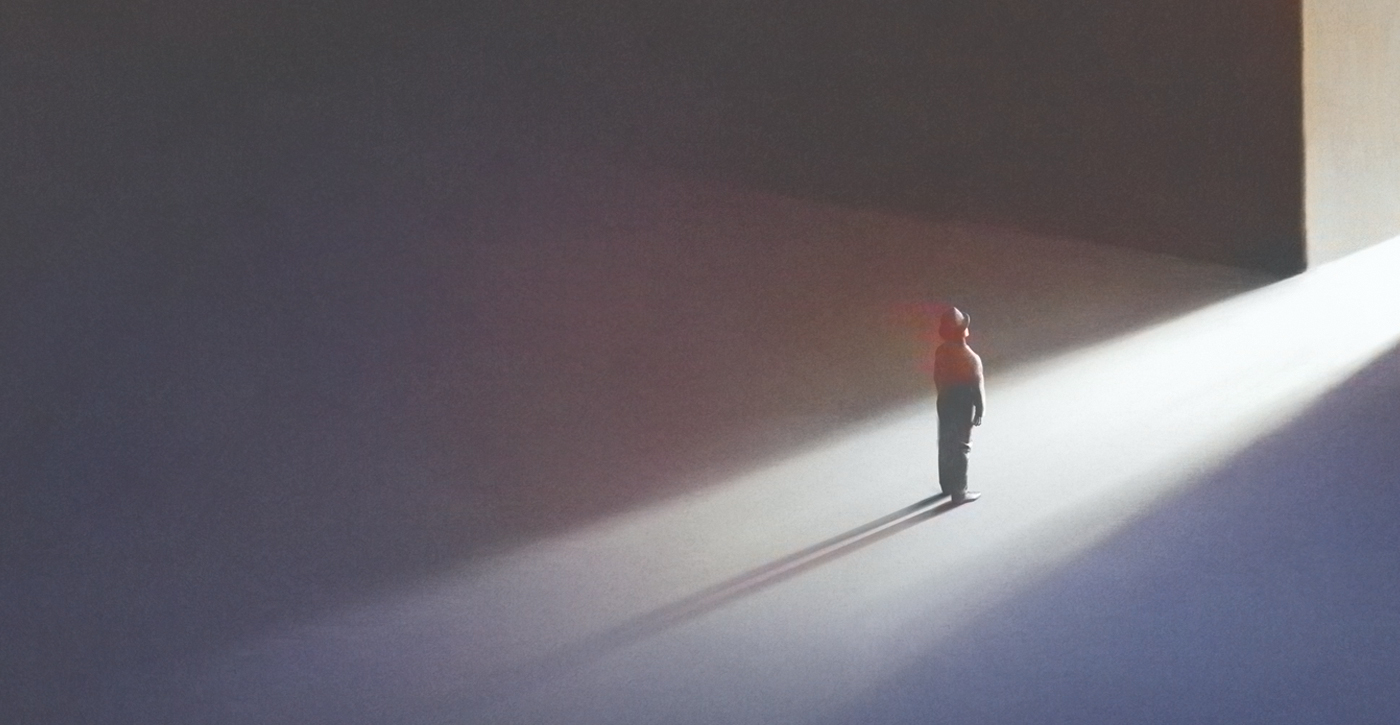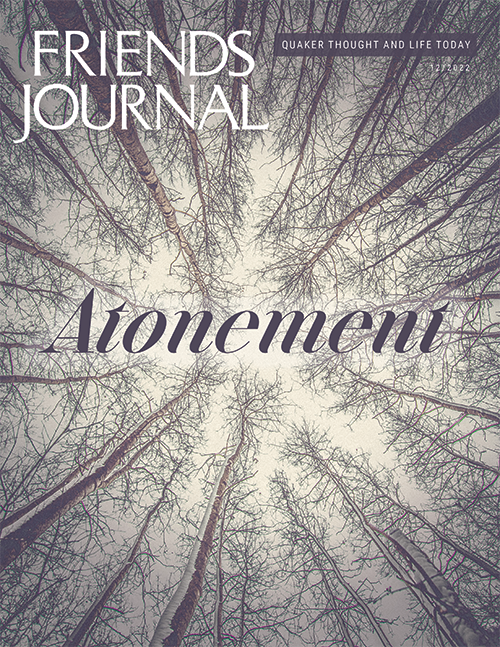The Mystery of Experiential Atonement
As a mystic, I surf the tide of visual and auditory symbols to reach the shore of my theology. The authorial signature of Spirit rather than ego comes in all forms: surprise, wit, beauty, bounty, and wisdom beyond what I can grasp with my intellect. An inward experience remains intact for long moments of witness, eventually bruised by the blunt instrument of my social-emotional psyche. There is bliss; there is energy and a sense of non-physical-optic Light where one knows oneself (“that of God within”) as well as the bones, sinews, aches, and yearnings of the coexisting denser self.
Atonement, in the bodily crucifixion/resurrection sense, our being “under the blood” (as I once heard a traditional Christian video put it) came to me in this way. Only through ineffable experience could I (personally) ever really understand a doctrine that I’d been brought up with but kept, respectfully and politely, at arm’s length.
When this occurred, I felt permanently changed. I have spoken to several Friends who have been graced by direct experience of the living Christ, and it is always a landmark for them. Where and how he was seen, what he was doing, what he said, and at what point in their lives serve as personal symbols that can lead to new and rich harvests throughout their entire lives. I am blessed when I hear such stories.
I must emphasize that I am equally blessed when I hear personal stories of mystical deliverance quite apart from the involvement of any recognizable deity. When one is worked through by what is sacred, one knows it with all certainty, and one becomes awake. There remains a lifetime’s hard work and growth to do, but these experiences become touchstones.
There is bliss; there is energy and a sense of non-physical-optic Light where one knows oneself (“that of God within”) as well as the bones, sinews, aches, and yearnings of the coexisting denser self.
In my case, this first experience—of what would become many—of the bounty, grace, patience, and humor of the living Christ revealed, without words, that every single one of us is deeply cherished. I was silently taught of a non-forfeitable protection of continuous forgiveness that has been granted to every single human soul, as well as the importance of choosing to magnify our inner Light—to raise our vibration as a collective whole.
In later experiences, Christ would support, cajole, or encourage, and I would listen—or not—according the amount of Light available within me. But in this first one, he radiated a palpable version of the Apostle’s Creed.
Insofar as I could previously grasp Christ’s role in offering atonement, I thought it was voluntary and interpersonal, being centered on his choice to forgive as an admirable model for our own. I had been moved by his prayer on the cross for our Creator to forgive those who had put him there. But after this direct experience, my understanding was more visceral. An earthly, bodily essence of what is usually described as sin came through—its being a form of attraction or direction—as well as a materiality to atonement itself. I was gently shown a direction to stretch toward: a very thin but bright stream to follow, as well as being a path forward to lead and expand. This dynamism helped me grasp the paradox of humanity’s being both recipient and co-creator of salvation.
What stood out to me after this experience was the stunned feeling I had from understanding that a principle—Jesus Christ’s resurrection as salvation—which I had seen as an opt-in was, in fact, true. For a millisecond, I was invited into a mystical magnetism: an earthly human body becomes dust and succumbs to a deep gravitational pull of formless thoughts laden with despair; then there is a reversal of that state toward the Light. That’s the best I can do right now to put it in words. The body is the whole of humanity. Its destruction inevitably accords with its weight and polarity (what might be translated as “sin”); yet my heart was shown that its restoration is promised by Christ’s love and action through resurrection, and that this promise is not past but active and dynamic, presently being fulfilled, with our participation. I received a half-an-instant’s snapshot of a bootleg video of a cosmic turning point (the Big Bang’s reversal?), a joyful return to the essence of who we are.
For a millisecond, I was invited into a mystical magnetism: an earthly human body becomes dust and succumbs to a deep gravitational pull of formless thoughts laden with despair; then there is a reversal of that state toward the Light.
I felt a hunger to be with others who understood and took joy in what I had learned. I entertained the idea of possibly transferring to a Christian church, but I remained in my unprogrammed Friends meeting for a few reasons. One was that I had young children. I had seen that Christians often unite under the term “believer,” and I did not want my children to become indoctrinated that sacred forms of belief should divide people. Instead, beginning when they were five and seven and lasting about five years, we read together regularly at home from an illustrated Bible. After reading, we would enter into silence, and I would ask them what rose up for them (something they were confused about or something that “drew them like a magnet”). This was a nourishing practice held every evening for a while, and my kids genuinely looked forward to it. Our meeting’s Godly Play / Faith & Play program also offered them a wonderful Judeo-Christian lexicon as well as dynamic, sensory-based exposure to Friends’ concepts and values.
My children, now in their mid- and late teens, both identify securely as Quaker but do not at the time of this writing identify as Christian or even theist. That does not bother me. The dynamic faith opening I’d had when they were small led me to develop a family practice that would simply plant good seed. What that seed grows into and the shape it takes is up to them, reflecting their own leadings and their stewardship. As a being whose heart had been worked through, I sought merely to show the resulting love and faith as authentically as I could.
A second reason I remained in my unprogrammed meeting is the fact that Quakers honor the mystical path. Even if such experience is not an overt touchstone for Friends’ collective worship as it was in centuries past, there remains support for our deepening these senses in community.
Thirdly and finally, fidelity to the path that had led me toward understanding meant that my heart’s being opened to the living Christ as guide and teacher did not compel me to worship in a more uniformly Christian community. It was never lost on me that my opening to the embodied mystery of atonement came by way of a non-Christian practice: the energetic practice of reiki, a Japanese healing art and Buddhist esoteric practice. Becoming attuned to this energy unlocked my ability to receive information in this way. My spiritual life at present still involves reiki energy work and precepts, Buddhist (Plum Village tradition) practices, and Christian prayer in equal measure. The non-contradiction of this blend, and our responsibility to grow and shift our practice over time as we are led, are aspects of Quaker faith that I treasure.
Atonement is a call to free yourself: a call to nurture nonviolence and radical forgiveness within your heart, and to muster up the courage to act accordingly. Therein lies the joy of growing closer to our divine source and to your own true self.
On the topic of sin, I have felt tension between my wish to enact compassion as unconditional love (“love one another as I have loved you” [John 13:34, 15:12, 15:17]) and my own limited extrasensory experience discerning dark from light, but I manage it peaceably within my experience. I have come to accept, with neither obsession nor judgment, the reality of powerfully negative energetic polarities: their existence, our human propensity to be drawn toward them, and the power of prayer / necessity of surrender to realign with that of God within ourselves instead.
Returning to the moment of the opening I have shared, I can’t say which was more of a surprise: that a permanent understanding of Christ’s atonement flowed into my heart through a Buddhist gateway (and I’d been introduced to reiki amid a mix of Quaker theists, Quaker nontheists, and Wiccans), or that I, a lifelong relativist, received through the same sensory gateway a nonverbal understanding of bleak, powerfully attractive forces that exist invisibly around and through us: Fox’s “ocean of darkness and death.”
I came to perceive sin palpably as dark energy, not merely—as my mind continues to have it—as a dismissible matter of convention. For several months the term “dreadful” came alive for me. I temporarily could not abide large swaths of normalcy. Museum rooms with displays of taxidermy felt like force fields of death. I found myself passing hastily through thresholds imbued with a negativity I previously could not sense and avoiding the basements of certain very old buildings repurposed as shops (I was living in England at the time).
This was an initiate’s sensitivity to being attuned to reiki at an intermediate level. When it dulled after a few months, I felt a selfish relief, as daily sensations became more tolerable. I had perceived in my everyday surroundings something I did not previously believe to exist. Yet I knew from the beginning to trust in my experience. Such trust was anchored by my Quaker faith.
I personally grasp the truth of Christ’s message “I am the gate; whoever enters through me will be saved” (John 10:9) and “no one comes to the Father except through me” (John 14:6) by recognizing that no one who earnestly seeks communion with the Divine avoids passing through the Gate. Christ’s gift of bodily atonement was given. Like a sunrise, it is present as a matter of course, and it is in harmony with other forms of sacred experience.
John 10:9 and 14:6 are widely read as requirements to profess Christian doctrine in order to be saved. Yet I have learned through experience that Light from other sacred traditions can open the heart to Christ’s everlasting gift. These passages do not therefore need to be read as doctrinal boundary markers, but can be seen as gentle yet powerful calls to become aware of the deeply loved and forgiven being you already are. Atonement is a call to free yourself: a call to nurture nonviolence and radical forgiveness within your heart, and to muster up the courage to act accordingly. Therein lies the joy of growing closer to our divine source and to your own true self.




Comments on Friendsjournal.org may be used in the Forum of the print magazine and may be edited for length and clarity.